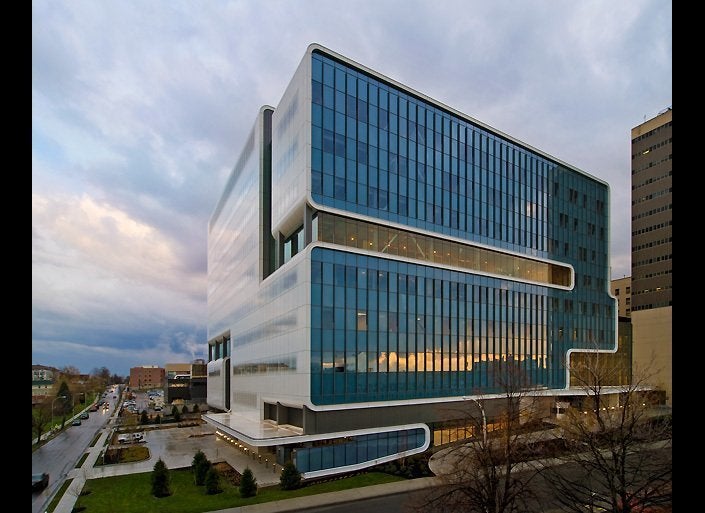
Scientific organizations have lagged behind the dynamic changes that have occurred in other businesses. Although science has consistently led the knowledge economy, its siloed nature, underfunding, and linear processes have progressively reduced it to a transactional operation.
Reacting to these conditions, a new paradigm is emerging -- one in which a new scientific generation is dispensing with traditional methods and moving to a creative mode focused on solving the world's challenges and enhancing the human condition.
"New Science" breaks down the walls between disciplines; blurs the boundaries between discovery and commercialization and bridges geographies. As science integrates innovation into people's lives and steers our behavior through inspirational solutions, it is becoming a creative occupation. Designers and architects are assisting in this transformation by providing new building forms that provide a platform for the transformation of science.
Three synchronized themes provide a framework for this transformational paradigm:
New Organizations
Over the last 30 years only around 2 percent of private industry funding traveled from industry to academia, and although every year the government outsources about 25 percent of its research to industry, there is little interaction between their scientists. The recession has exacerbated the problems of science. Scientific corporations face large-scale patent expirations in highly profitable drugs. Government funding is dropping as deficit initiatives kick in and university funding is at an all time low.
In response, a new wave of creative scientific partnerships are emerging with pooled funding, shared skill sets and new value definitions. Corporations are teaming boutique subsidiaries with agile academics to produce fast track highly focused solutions. Governments are reinforcing an aging scientific workforce by inviting industry and academics to partner in new forms of crowd-sourced discovery.
The Gates Vascular Institute is a transformational facility integrating the University at Buffalo and Kaleida Health into a public / private partnership.
Here, in a revolutionary facility, these two diverse organizations operate under a radical methodology that simultaneously educates a new breed of physician scientist, commercializes discoveries and dispenses healthcare.
Cal IT2 at the University of California San Diego brings together academia and industry to focus on accelerating innovation, product development time and job creation in nano technology, life sciences, information technology, and telecommunications. Here filmmakers and physicists rub shoulders with biologists and computer scientists to address large-scale societal issues and test prototype infrastructure in real world situations.
New Culture
Scientists' biggest challenges are low budgets, lack of or inability to collaborate and skill shortages. Most scientists work in uninspiring facilities in hierarchical organizations that seek control by imposing uniformity. Scientists are separated from each other in formally arranged spaces, reflecting linear processes and static functionality. Status is reflected by size of internal real estate and the allocation of enclosed offices.
With over 50 percent of scientists born after 1980 and over 70 percent of labs up to 50 years old, traditional notions of scientific work are being eroded. A new wave of highly collaborative, generationally diverse scientists is demanding a radically new open source workplace, where office, lab and meeting room converge and problems can be addressed in collaborative coexistence.
At the CJ Corporation, the "Only One" R&D Center in South Korea is a high quality, highly branded lifestyle experience that was designed to attract the best scientists and stimulate creativity through interaction. In this melting pot for the mobile scientist, multiple disciplines are thrown together in an interactive cocktail of continuous collaboration fueled by high technology, hotel style amenities, and high-end retail.
The Howard Hughes Medical Research Institute's Janelia Farm Campus is a pioneering research center where small teams of engineers, chemists computer experts and biologists pursue mankind's most challenging problems. Its uniquely innovative and collaborative atmosphere encourages scientists to work creatively, following their intuition without the restrictions of conventional scientific strictures.
New Technology
Today's labs are largely untidy, immovable and inefficient. Recent research indicates scientists spend less than 40 percent of their time in the lab and that 50 percent of lab space is incorrectly used. Machines already produce over 50 percent of all scientific data and this growth is accelerating exponentially. Increasingly, new directions in science are fueled as much by new technologies as by new creativity. The convergence of instrumentation, communication, visualization and simulation is demanding rapidly changing, data intensive environments never before envisioned. For the scientist, a variety of powerful personal devices are now enabling a constant dialogue between scientific data and personal communication. Stuttering exchanges are being replaced by untethered information availability on common platforms enabling real time solutions to be produced in parallel by scientists, clinicians, engineers, product designers and marketers.
The Sabanci University Nanotechnology Institute leads the convergence of scientific and building technologies. This smart structure is a scientific tool that supports highly specialized environments focused on nano-scale solutions to health, environment and energy challenges. Constant change is embraced through a "universal grid" structure capable of accommodating continual change as scientific teams come together, develop their solutions and disband.
The Wellcome Trust Sanger Institute utilizes high performance computing in parallel with traditional scientific methods to build on its position as a leader of the Human Genome Project to sequencing not one but tens of thousands of human genomes today in projects such as UK10K and ICGC, in order to understand the influences of genetic variation on health. One of the most extensive information technology infrastructures in the scientific world has been enabled by a unique building design that enables almost continuous information technology reshaping.
Science is at a tipping point as it grapples with the changes forced on it by a shrinking economy and the demand to solve human centered problems. So why waste a good crisis? The most forward thinking scientists are already using design thinking to play a meaningful role in defining the future. It is up to us as designers to create the new breed of facilities within which scientists can practice their art.
